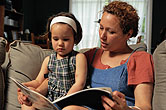- Skip Storing This Everyday Product in the Fridge Door
- Green Tea + B3 Pairing May Boost Brain Health
- Navigating Your Midlife Crisis: Embracing New Possibilities
- City Raccoons Showing Signs of Domestication
- Mapping the Exposome: Science Broadens Focus to Environmental Disease Triggers
- One Week Less on Social Media Linked to Better Mental Health
- Your Brain Changes in Stages as You Age, Study Finds
- Some Suicide Victims Show No Typical Warning Signs, Study Finds
- ByHeart Formula Faces Lawsuits After Babies Sickened With Botulism
- Switch to Vegan Diet Could Cut Your Greenhouse Gas Emissions in Half
Can Brain Scans Help Predict Young Children’s Reading Abilities?


Scans of young children’s brains might help predict how they learn to read. This finding could potentially allow doctors to identify those with dyslexia and other reading difficulties early on, preliminary research suggests.
“Early identification and interventions are extremely important in children with dyslexia as well as most neurodevelopmental disorders,” the study’s senior author, Dr. Fumiko Hoeft, an associate professor of child and adolescent psychiatry at University of California, San Francisco (UCSF), said in a university news release.
“Accumulation of research evidence such as ours may one day help us identify kids who might be at risk for dyslexia, rather than waiting for children to become poor readers and experience failure,” Hoeft said.
The study, published recently in Psychological Science, involved 38 kindergarteners. As the children were learning to read at school, the researchers used brain scans to examine the white matter in the children’s brains. White matter is essential for perceiving, thinking and learning, according to the researchers. The development of white matter was monitored until the kids reached third grade.
Children in the United States begin learning to read in kindergarten. By third grade, they are usually skilled readers, the researchers explained.
The study found that development of the children’s white matter was a strong predictor of their reading abilities.
“Examining developmental changes in the brain over a critical period of reading appears to be a unique sensitive measure of variation and may add insight to our understanding of reading development in ways that brain data from one time point, and behavioral and environmental measures, cannot,” said study lead author Chelsea Myers, lab manager in UCSF’s Laboratory for Educational Neuroscience, in the news release.
“The hope is that understanding each child’s neurocognitive profiles will help educators provide targeted and personalized education and intervention, particularly in those with special needs,” Myers added.
Although there are other commonly used measures to assess children’s reading readiness, such as their IQ, early language skills, socioeconomic states and a family history of reading problems, the study found brain scans improve the accuracy of early reading predictions by 60 percent.
“What was intriguing in this study was that brain development in regions important to reading predicted above and beyond all of these measures,” Hoeft pointed out. “We show that white matter development during a critical period in a child’s life, when they start school and learn to read for the very first time, predicts how well the child ends up reading.”
More information
The American Academy of Pediatrics provides tips on how to help your child learn to read.
Source: HealthDay
Copyright © 2025 HealthDay. All rights reserved.










